Let's go down memory lane and see where W7BRS came from.
In 1931, my grandfather, Hershel Wandling was a prodigious electronics designer. At the age of 17 he and his friend John Grubel took the test to get their amateur radio licenses. Grubel passed the Extra ticket to earn a 1x2 call, W7RT. My grandfather earned a 1x3 call, W7BRS.
I found a photo of Hershel (and his brother Kenneth), and John Grubel. They all attended Franklin High School (the same high school my parents attended incidentally).
Here they are in front of Franklin High School with their club The Franklin High Radio Club (Seattle, WA)

- John Grubel, W7RT (SK), is bottom row, third from right. John Grubel's younger brother (name I cannot remember) is in bottom row second from left.
- Hershel Wandling W7BRS (SK), is bottom row, second from right.
- (Kenneth Wandling ("SK"), Hershel's brother) is top row third from right (he was mostly interested in music and audio hardware not radio)
Hershel was the real genius, designing receivers and antennas (tube based) the same way you might do flawless long-division on paper -- he could do on paper by drawing out the schematic for receivers/transmitters as fluently.
Also, he could pound the brass (CW) at 50+ WPM and copy it as well. When I tell people that, they roll their eyes. From multiple accounts of those who knew his operating capabilities, that is the story they tell me. Hershel could send and copy at blistering speeds.
W7BRS Test Results
Here's the original test results for W7BRS (pre-FCC). He was 17 years old.
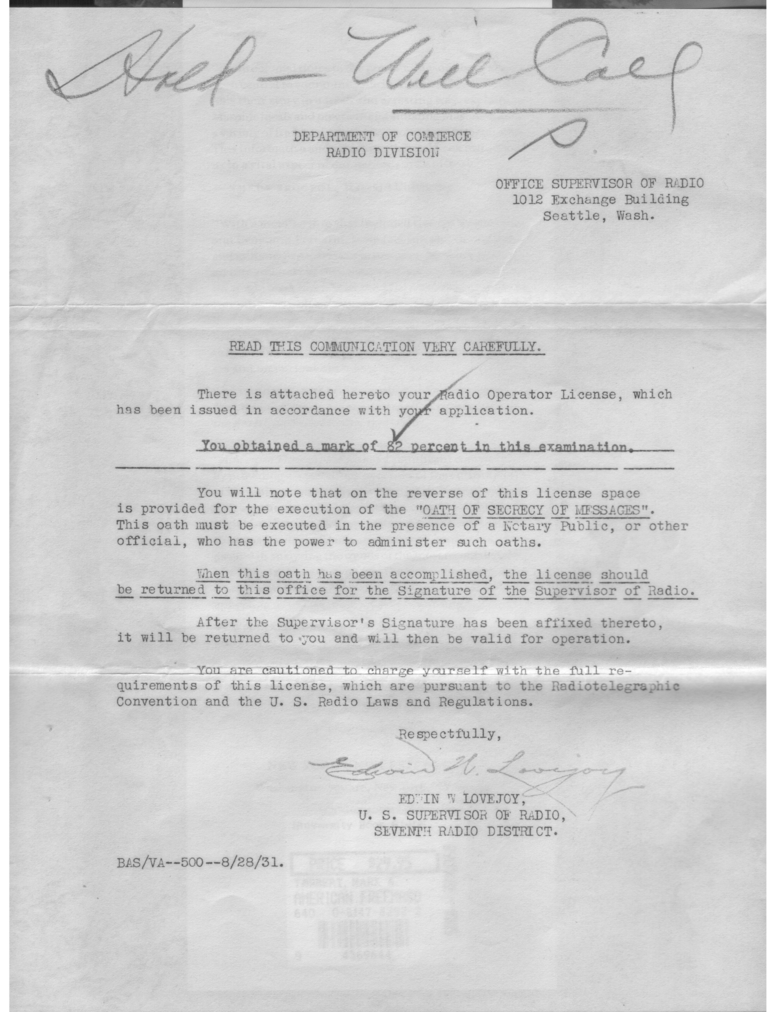
Original License
Pre-FCC certificate for the license:
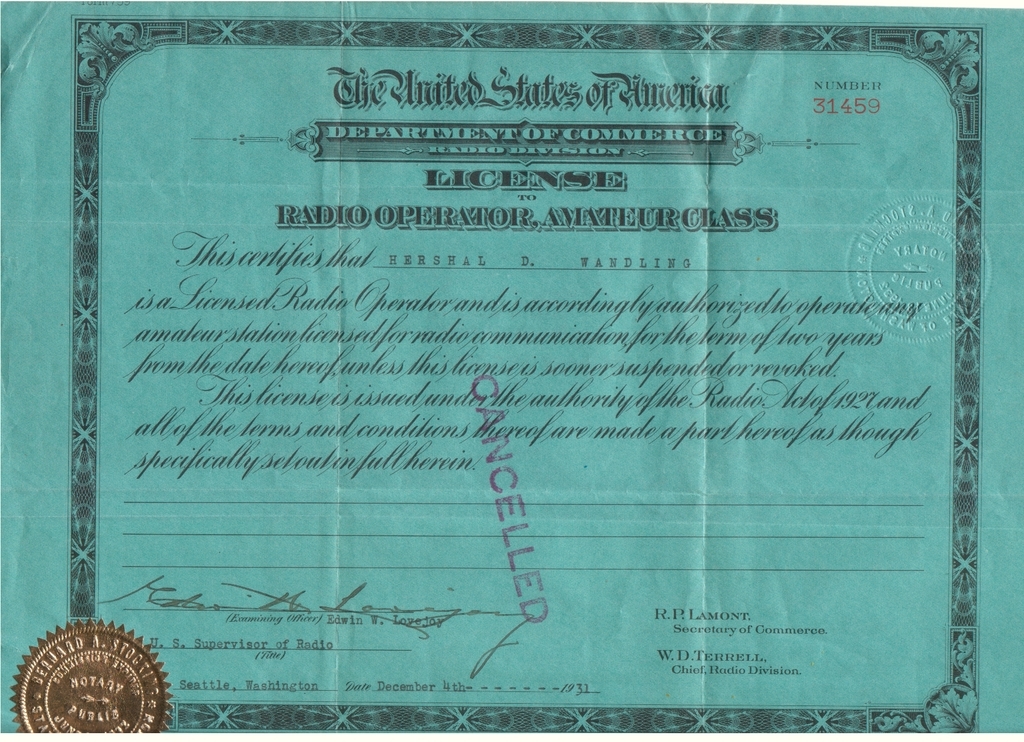
Other licenses and ID cards:
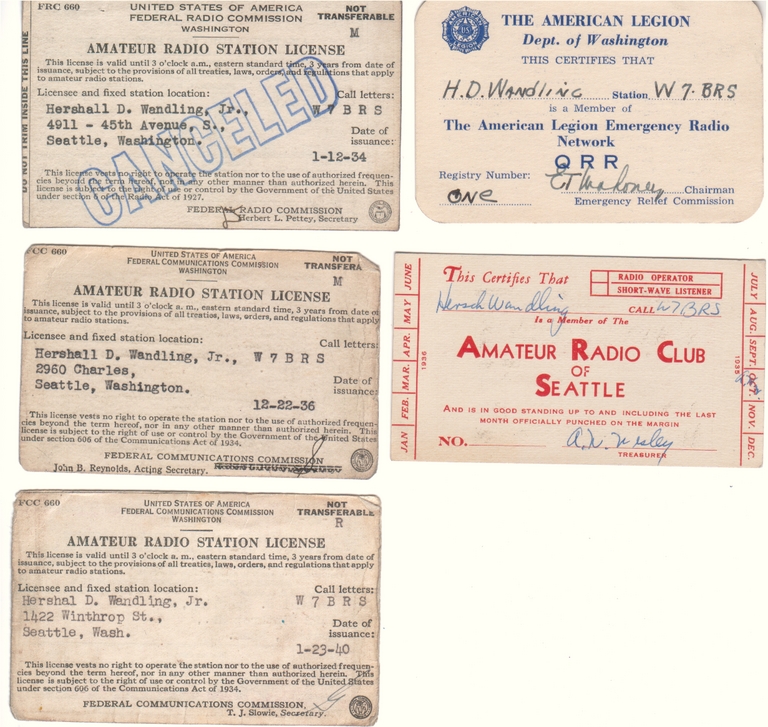
Second license, W7CCZ
He also had a second license (don't ask me how that worked) for experimenting with 2 meters at the time (1932-1933) ?
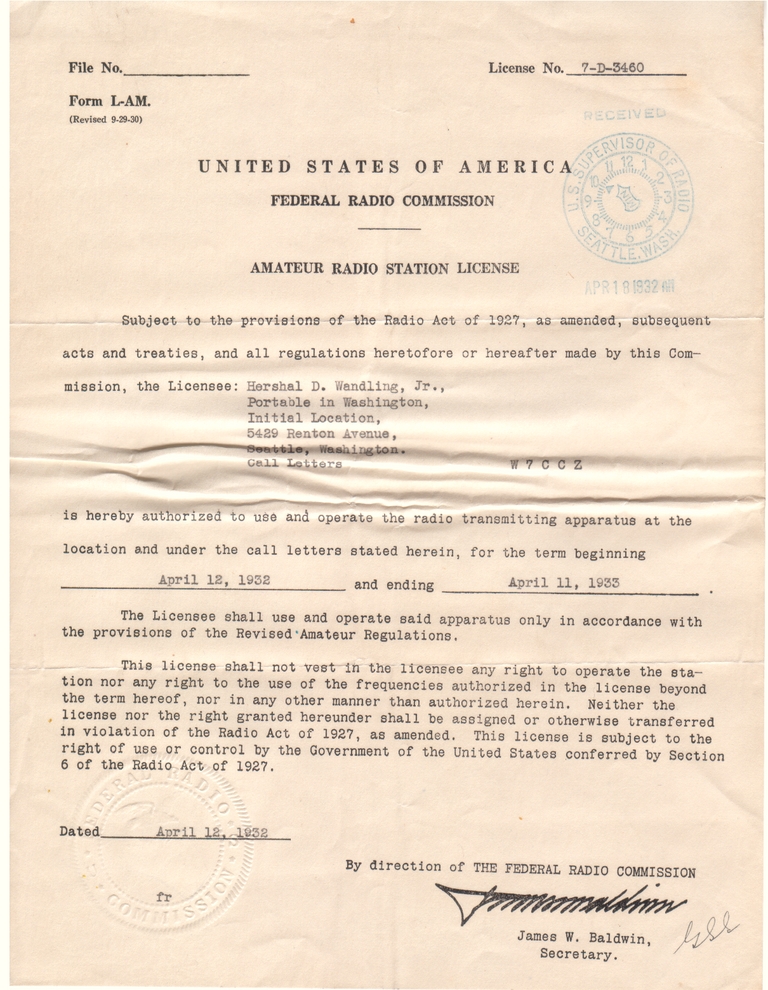
Hershel and the OSS
Then at some point Hershel goes into the Navy, enlisted and he was decommissioned 22 years later a Mustang Sailor (entered E3, decommissioned a Lt. Cmdr.)
His work dealt with radio technology in the war and intelligence gathering.
Served in the OSS and did secret work for direction finding antenna and Receivers for the Navy intelligence. He developed the early form of phased key shift encoding (according to the history told to me, but a lot of what he did was not discussed given his penchant for withholding information).
Suffice to say, he was a radio man.
Fast forward a few more years and he opens up a business in Seattle on 1st and University Pacific Coast Electronics and dealt with all sorts of electronics parts and radios. He sold Hallicrafter radios among other brands and always had the latest gear.
Then a bit later I came along. Given my family history in radio and electronics I was introduced to radio around the age of 5 (early 70s) and was building equipment and reading ARRL handbooks then. That led me into modern computer work and software. The embedded systems I deal with are reminiscent of the kinds of hardware that I longed to work with as a kid.
QSL
It was not until about 2015 or 2016 that I learned a lot of details about Hershel's radio work. I was given a bundle of papers and cards and it all was a fresh history lesson on what he actually did with radio:
Here's one of his earlist QSL cards:
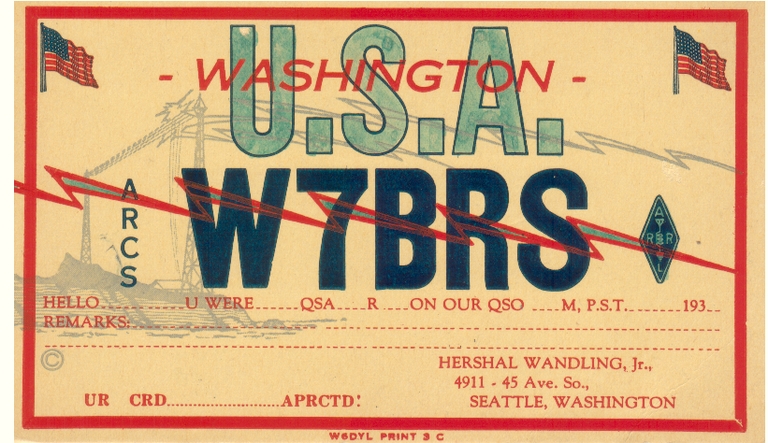
I think there was a brief period of time in the 60s-70s that the callsign (W7BRS) was held by a stranger to the family. I think the work load of the electronics store (Pacific Coast Electronics) took up all his time. But as I noted, in 2016-2018 I was able to (vanity call assignment) reacquire the call sign in the family again since it began in this family in 1931.
Current W7BRS
My own career had to take priority as well and so I didn't get my license until 2006 and at the time that was Tech-Plus
What happened is that on a family trip to Los Angeles, I met with my YL's great uncle Art Rutledge, WA6SLI [ editor note: at present time his health is not good so he has not been able to renew his license, but I don't expect he will be back on the ham bands. I need to inquire about putting that license in a reserved state, perhaps. Ideas welcome.]
On that visit we stopped by "the Candy Store" (which is what he called Ham Radio Outlet, which was in his neighborhood, lucky guy!)
This was 1999 and Art was showing off his Kenwood radio and Henry full legal limit amplifier (pair of 3-500Z finals). His home required the use of a vertical antenna so he used a GAP Titan off the garage roof. Art was very skilled at working the radio and his casual manner and light touch on the dial showed me how fun the hobby could be. I was already hooked on electronics, but having been too young to witness Hershel on the radio I didn't get a hands on experience until Art showed his station.
I immediately bought the ARRL Handbook and began to read. But work/career got in the way yet again and I had to put it off. I'm not sure what precipitated it, but around 2005 I was reorganizing the workshop and found the Handbook and decided to move forward. So in 2005 I got Gorden West's study books for all the licenses.
I read them all and then took the practice tests for all of the licenses at once. I studied them in reverse (Extra, then General, then Tech-Plus -- which I advise because there is a lot of overlap in the theory and operation). Anyway, at the time Code was a requirement for Tech-Plus, so I took that test first. 5 WPM. Passed that then took General, passed that and then failed Extra. I re-took the Extra ticket the next month and passed. So here I was all license, no radio.
No Radio, Extra ticket.
How does that happen? To have an extra ticket but not own my own radio -- of any kind? Don't ask me why, but it happened. I do not recommend that path. I think all hams should have a radio to listen with even as they move forward after Technician.
So, I finally pooled the money together, and made a big purchase at Ham Radio Outlet (Portland, Oregon).
I bought a FT-897D, a tuner, some coax, a balun, and log book. Just before placing the order, I had a bad accident and broke my leg (fibula) so I was on crutches. The UPS truck dropped off the radio on my porch, I am on crutches and so I had some help to move the boxes (sealed) in my shop.
A few weeks go by when I'm able to stand up right without pain (but still on crutches). I am staring at the stack of radio boxes from HRO and wondering what now? One night, I believe it was about 2 am (pitch black outside) with a flashlight and a spool of wire, I am throwing a dipole into the trees next to my shop. I live in a rural area so it's just trees and nothing. I was expecting a bear to appear because that happens time to time.
I get the dipole antenna into the trees next to the shop, hoist up the balun and connect the coax to the back of the FT-897D. I fiddle with the controls and scan the manual a bit (still not sure how the radio works) and I listen. The first station I heard was Harry, KH6FKG (SK). Booming signal on my very simple dipole broadside to the South/North.
I worked him and then Jack, W7JK (SK). On twenty meters.
The real fun began when I met Stuart, KH7DX on 20m with the same antenna a few days later. Stuart was on 20 working Abdallah, 9K2GS. I could barely hear 9K2GS, but Stuart was S9+.
I don't know why I did it, but during a gap I dropped my call and nice as Stuart was, he took my call. I explained my newness and instead of giving me the slide, he asked Abdallah if he could hear me.
Let me pause a second.
First, my first call was KE7JVD (a mouthful) So just saying the callsign was work. I would be tempted to get my original callsign again but it is a terrible callsign!
Second, you need to understand (or try to remember!) that time in your ham radio life when other operators actually cared enough to let others join in (or if not join, at least pause to let a new ham get a crack at working some DX). I think this falls into the bucket of Elmering, at a distance. At least that was how it felt.
When Stuart took my call meant the world to me for many reasons.
What KH7DX did then was remarkable and all too rare these days in the modern ham world. Let the new hams in. Teach the new hams how to work DX. Give a lesson by example how to treat each other on the bands.
True, it was 2 am. There was no pile up and it's probably the case that Stuart was in a Schedule with Abdallah. (or maybe not, I did not hear the very first part of that QSO).
But the point is -- what made me the most impressed with ham radio -- the behavior of Stuart, Abdallah, and the rest of the operators I soon would be talking to on "plenty meters".
Nets
I found a local "net" on 28.380 run by Jim Fish, K7NCG, who took me under his wing and eventually sold me some parts to build a real amplifier -- the monster homebrew 2kW that I used ever since.
Mike and Key
I think it was around this time 2009-2010 that I was involved with Mike and Key ARC and went to a few meetings, ate a few donuts, and talked about ham radio with some folks there. I also participated in one Field Day at Fort Casey for the club, K7LED.
Satellite
At a Mike and Key Radio club, a ham Bob Johnson, W7LRD , gave a talk on amateur satellite work and that really hit home. I talked to Bob and he taught me about AMSAT, and the historically beloved AO-7 satellite. I worked satellites for a while off and on. It was difficult!
Bob is more than just a amatuer satellite expert, he's a true friend and mentor. He has all the right stuff when it comes to ham radio -- passion, skill, patience, and strong interest to keep learning. I hope some day to be like him.
Kid and DX
When my son was about old enough to work the radio (8-9 years old?) he made his first contact on the radio and it was DX.
He called CQ on 20 meters and it was Mike, 3D2MP . He knew my son was making his first contact and it was DX (I had to explain a bit after the QSO with Mike, and he was generous with his time). I sitll have the QSL card!.
Here is the kid working that day:
Audio Chain
2009 ? So the home brew linear was working great, or so I thought until I was on 20 meters one afternoon and a very nicely worded warning from KA7GKN Marty tells me "hey, uh you're shooting buckshot 30 Kc wide across the band. YOU ARE NOT LINEAR." Oh my I was so embarassed. I said "thank you!" and went QRT for a few days. I found the problem -- the homebrew linear was wired up fine and in good order, but the COOLING system was so poor that the tubes were getting to hot, and not active in a linear fashion. After re-doing the cooling system (changing nothing else!) the problem went away and I confirmed with a Heathkit HO-10 scope investigation of the classic trapezoid pattern. I owe a lot to my effort to improve my audio chain quality to KA7GKN Marty (do you have one of his pens?) and a side kick, KK7TV Randy, and a few others of the 14.187 Mhz group that calls themselves "the supper club" aka "audiophiles of 20"
Most Recently
Around 2008-2009, I was about at 50-60 DX entities. Not very good. I read the Complete DX'er and that evening, after absorbing the logic and wisdom of the book, I netted 11 (eleven) new countries in one night. I was doing it all wrong before.
A turning point (or there about) was when I found a book called The Complete DX'er by W9KNI Bob Locher
Improvements that changed the situation:
- Listen to the whole band, identify every signal.
- Use CW
- Go to step 1
The most fun I had that 11+ country night was on the local 2m repeater. A close friend at the time KC7QRY (SK) Michael would really egg me on to keep chasing more DX. The rest of the curmudgeons on the 2m repeater (N7XS Dean, NX7DX Nelson, WA7HQG (SK) "Little John", WA7PVE Michell, and others) would also encourage each other to keep chasing DX and it spurned me on.
I cannot forget to mention W7LY (SK) Ed from Astoria. We did our best to push the limits of 2m SSB between Seattle and Astoria a number of times. He also had a lot of wisdom and remarks to help catch some new DX. A really nice guy.
My DX Aku
Then a very interesting thing happened. I found this book called DX Aku by Dr. Bob Schmieder, KK6EK. He documented his experience on Easter Island and the DX-pedition XR0Y/Z. The frontier of the ham radio experience we enjoy today is in large part due to the fundamental achievements of Bob with respect o DX-peditions, logging, and science.
I made an effort in 2012-2013 and reached out to KK6EK Bob, to ask advice on planning a DX-pedition. We had several rounds of interesting email and I was very close to pulling the trigger on getting the project really off the ground -- when my work at Microsoft took every hour of every day for the next 2-3 years (Xbox One Hardware Development).
- I had the island picked out.
- I had the local government on speed-dial.
- I had the initial plans on paper and a general idea of what I wanted the DX-pedition to do.
But it had to all be shelved. Maybe some day.
The point is, the DX Aku - that spirit we call by other names, the Muse, the better Angel, the subconscious, pulled me even deeper into understanding ham radio, DX-peditions and the whole other side of the hobby. I worked DX before, but I wanted to be on the other side of the QSO -- badly. I had spent time as a young man in Alaska fishing for crab in the Bering Sea. I've been in rough places, lived roughly, so the idea of survival and adventure was very appealing to me. There is a lot I did not know. There is still a lot I do not know. But I want to learn.
I will say that another ham Bob Allphin, K4UEE, did return my mail with questions about DX-peditions (thanks Bob). What is it with all the Bob's in my life who mentor me.
- 1989 - Bob Hayes WWU Computer Science mentor
- 2006 - Bob Johnson W7LRD
- 2011 - Bob Schmieder KK6EK
- 2012 - Bob Allphin K4UEE
Now we get to present day (good job sticking with this web page)
I put the big loop antenna back up in 2020 and worked DX on 40 meters, a lot.
Then the wind took down the loop.
I put a Zero-Five Antenna up. (43 foot multi-band) and it is very good, but not as good as the big 500+ foot horizontal loop.
I succumbed to temptation and have been doing FT-8. I hate FT-8 and I love FT-8. I love to hate it. I'm going to try to just stop using it because it's killing my DX-Aku spirit, then again if you need a ATNO (All Time New One), what are you going to do if they are only working FT-8 ?
All of the essential details of my station are on my web site.
Thanks for reading and I look forward to our next QSO.
End Notes
Regarding John Grubel, W7RT (SK)
Later in life as an adult, here is a picture of John.
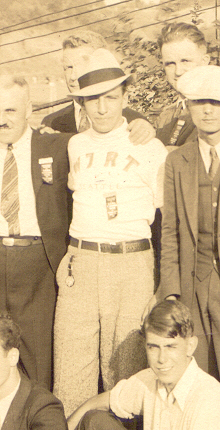
And one of John's QSL cards:
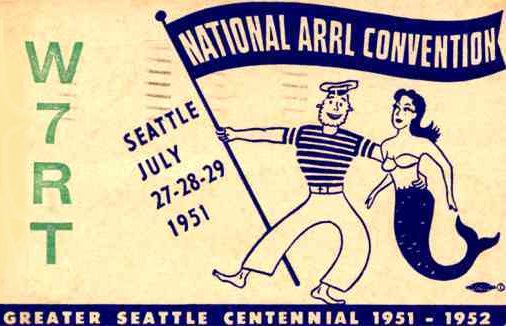
Hershel and John were long time family friends. It is that reason why I actually have a good set of John Grubel's ham radio memorabilia.
